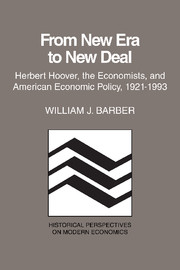Book contents
- Frontmatter
- Contents
- Preface
- Prologue: The vision of a new era in the 1920s
- 1 The ingredients of a model of a new economics
- 2 Challenges to the new economics of the 1920s
- 3 The new economics at center stage in 1929
- 4 Activating the stabilization model in late 1929 and 1930
- 5 Preliminary readings of the results of the stabilization strategy
- 6 The unraveling of the first official model in 1931
- 7 Shifting course in late 1931 and early 1932
- 8 Renewing the offensive in February and March 1932
- 9 The economists and their views on policy for 1932
- 10 Official model II as shaped in May 1932 and the aftermath
- Epilogue: Transition to the New Deal – continuities and discontinuities
- Notes
- Selected bibliography
- Index
Epilogue: Transition to the New Deal – continuities and discontinuities
Published online by Cambridge University Press: 19 October 2009
- Frontmatter
- Contents
- Preface
- Prologue: The vision of a new era in the 1920s
- 1 The ingredients of a model of a new economics
- 2 Challenges to the new economics of the 1920s
- 3 The new economics at center stage in 1929
- 4 Activating the stabilization model in late 1929 and 1930
- 5 Preliminary readings of the results of the stabilization strategy
- 6 The unraveling of the first official model in 1931
- 7 Shifting course in late 1931 and early 1932
- 8 Renewing the offensive in February and March 1932
- 9 The economists and their views on policy for 1932
- 10 Official model II as shaped in May 1932 and the aftermath
- Epilogue: Transition to the New Deal – continuities and discontinuities
- Notes
- Selected bibliography
- Index
Summary
As president, Herbert Hoover understood one of the basic insights of a theoretical system later to be identified as Keynesianism: that the behavior of the macroeconomic system is determined by the aggregate volume of spending. Indeed, he grasped this point as well as did anyone of his time – and better than did most of the economists in that period. This was the basis for his initial effort in depression fighting when he called for accelerated construction spending by public authorities and for increased capital outlays by the major private investors. Similarly, his appeals to employers to resist wage cutting was a plank from what later would be regarded as a Keynesian platform.
Nor did he lose sight of the importance of demand management when he made tactical adjustments in his programs in late 1931 and 1932. At first glance, the stance he then took – with his insistence on the importance of a balanced budget and on tax increases to achieve it – seems to be at odds with the objective of stimulating spending in a depressed economy. From Hoover's perspective, such a reading of his actions would be incorrect. The larger goal remained the same. In the circumstances of the time, however, the ultimate objective would be beyond reach unless an instrumental one, solvency in the banking system, could be secured first. The immediate priority was thus to ensure that the institutional preconditions for recovery in spending were in place.
- Type
- Chapter
- Information
- From New Era to New DealHerbert Hoover, the Economists, and American Economic Policy, 1921–1933, pp. 189 - 196Publisher: Cambridge University PressPrint publication year: 1985

